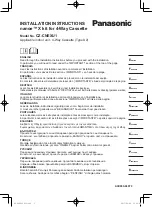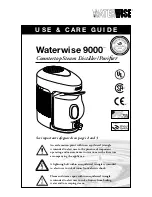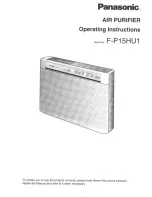
37
HEATING
In the Heating Mode (W1 and G on the thermostat), the ISC board
sends power to W on the IGC board. Assuming the unit is con
-
trolled through a room thermostat set for fan auto, the indoor-fan
motor will energize and the outdoor-air dampers will open to their
minimum position. The ISC board upon seeing W1 and G ON will
turn the indoor fan to high speed
The IGC board starts its gas ignition process. A check is made to
ensure that the rollout switch and limit switch are closed. If the
check was successful, the induced draft motor is energized, and
when its speed is satisfactory, as proven by the “hall effect” sensor,
the ignition activation period begins. The burners will ignite with
-
in 5 seconds. If the burners do not light, there is a 22 second delay
before another 5 second attempt. This sequence is repeated for
15 minutes or until the burners light. If, after the 15 minutes, the
burners still have not lit, heating is locked out. To reset the control,
break 24VAC power to the thermostat.
When gas ignition occurs, the IGC board will continue to monitor
the condition of the rollout switch, the limit switches, the “hall ef
-
fect” sensor, as well as the flame sensor.
When W1 is turned OFF, the IGC board turns off the gas valve.
The IGC board has a delay time before it turns IFO=OFF. At this
time, the ISC board sees W1=OFF and IFO=ON. The ISC will
keep the indoor fan ON high speed. Once the IGC board delay
times out, the ISC board will see W1=OFF and IFO=OFF, which
then turns the indoor fan OFF.
If the call for W1 lasted less than 1 minute, the heating cycle will
not terminate until 1 minute after W1 became active. If the unit is
controlled through a room thermostat set for fan auto, the indoor
fan motor will continue to operate for an additional 45 seconds
then stop. If the over temperature limit opens after the indoor mo
-
tor is stopped, but within 10 minutes of W1 becoming inactive, on
the next cycle the time will be extended by 15 seconds. The maxi
-
mum delay is 3 minutes. Once modified, the fan OFF delay will
not change back to 45 seconds unless power is reset to the control.
A LED indicator is provided on the IGC to monitor operation.
When additional heat is required, W2 closes and initiates power to
the second stage of the main gas valve. When the thermostat is sat
-
isfied, the gas valve closes, interrupting the flow of gas to the main
burners.
EconoMi$er
®
X (Factory Option)
The EconoMi$er X system is an expandable economizer con
-
trol system, which includes a W7220 economizer module (con
-
troller) with an LCD and keypad (see Fig. 46). The W7220 can
be configured with optional sensors.
Fig. 46 — W7220 Economizer Module
The W7220 economizer module can be used as a stand-alone
economizer module wired directly to a commercial set-back
space thermostat and sensors to provide outside air dry-bulb
economizer control.
The W7220 economizer module can be connected to optional
sensors for single or differential enthalpy control. The W7220
economizer module provides power and communications for
the sensors.
The W7220 economizer module automatically detects sensors
by polling to determine which sensors are present. If a sensor
loses communications after it has been detected, the W7220
economizer controller indicates a device fail error on its LCD.
SYSTEM COMPONENTS
The EconoMi$er X system includes an economizer module,
20k mixed air sensor, damper actuator, and either a 20k out
-
door air temperature sensor or S-Bus enthalpy sensors.
Economizer Module
The module is the core of the EconoMi$er X system. The mod
-
ule is mounted in the unit’s control box, and includes the user
interface for the system. The W7220 economizer module pro
-
vides the basic inputs and outputs to provide simple economiz
-
er control. When used with the optional sensors, the economiz
-
er module provides more advanced economizer functionality.
S-Bus Enthalpy Control Sensors
The sensor is a combination temperature and humidity sensor
which is powered by and communicates on the S-Bus. Up to
three sensors may be configured with the W7220 economizer
module.
CO
2
Sensor (optional)
The CO
2
sensor can be added for Demand Controlled Ventila
-
tion (DCV).
SPECIFICATIONS
W7220 Economizer Module
The module is designed for use with 2 to 10 vdc or bus com
-
municating actuator. The module includes terminals for CO
2
sensor, mixed air sensor, and an outdoor dry bulb sensor. En
-
thalpy and other options are available with bus sensors.
User Interface
Provides status for normal operation, setup parameters, check
-
out tests, and alarm and error conditions with a 2-line 16 char
-
acter LCD display and four button keypad.
Electrical
• Rated Voltage —
20 to 30 vac RMS, 50/60 Hz
• Transformer — 100 va maximum system input
Table 16 — Low Ambient Temperature Outdoor Fan
Control
48LC**
NO. OF
FANS ON
NO. OF
FANS OFF
SWITCH
OUTDOOR
FAN
SELECT
SWITCH
RPM
14
3
0
SPST
Up
250
17
4
0
SPST
Up
250
20
4
0
SPST
Up
250
24
6
0
SPST
Up
250
26
6
0
SPST
Up
250
Содержание 48LC 14
Страница 27: ...27 Fig 38 Integrated Gas Control IGC Board RED LED STATUS...
Страница 81: ...81 Fig B Typical Electromechanical Control Wiring Diagram 48LC 14 26 APPENDIX D WIRING DIAGRAMS...
Страница 82: ...82 Fig C 48LC 14 26 Systemvu Control Schematic APPENDIX D WIRING DIAGRAMS...
Страница 83: ...83 Fig D 48LC 14 26 RTU Open Control Wiring Diagram APPENDIX D WIRING DIAGRAMS...
Страница 85: ......
















































